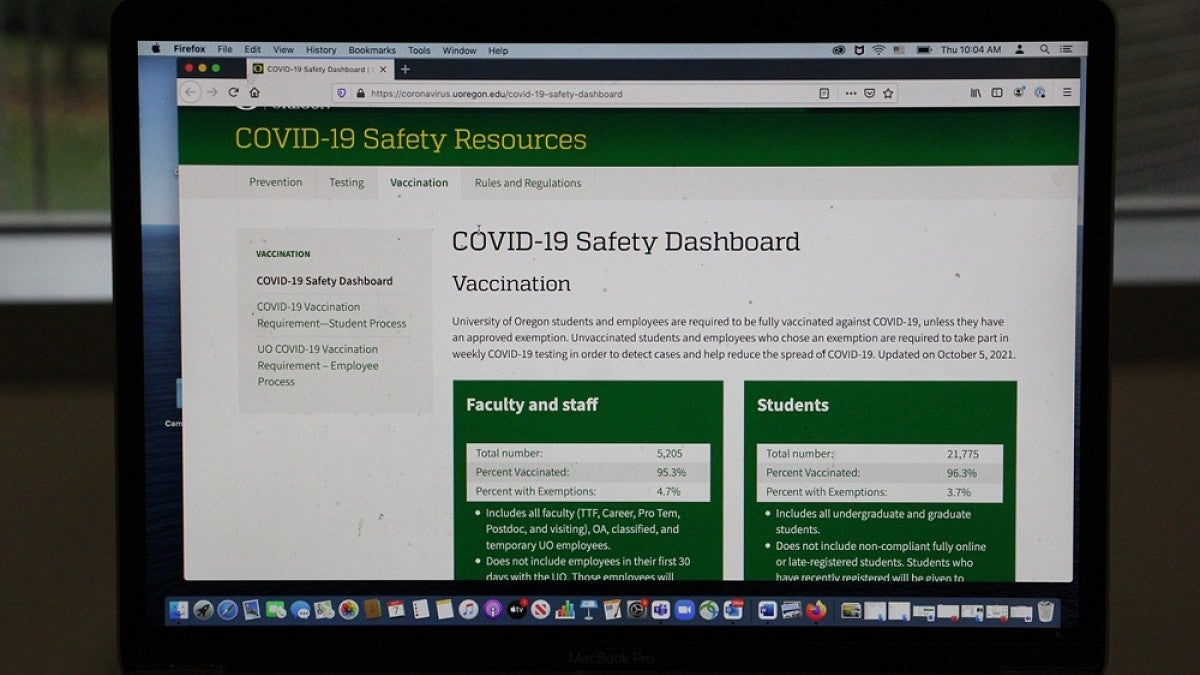The University of Oregon has launched an updated COVID-19 Safety dashboard with information about current UO employee and student vaccination rates, positive cases and the campus’ COVID-19 risk assessment using the latest scientific data.
The new dashboard was updated to reflect that all the deadlines for UO students, staff and faculty to be fully vaccinated or request an exemption have passed. It also provides additional information that UO leaders are using to monitor and assess COVID-19 risks levels as part of the comprehensive layered approach to protecting campus and the community.
More than 95 percent of faculty and staff and 96 percent of students are fully vaccinated. The fewer than 5 percent of employees and students who requested exemptions are required to test weekly to help prevent the spread of the virus.
The path to compliance was simple. Students either had to upload their vaccination card or claim an exemption for a medical reason or a nonmedical reason, such as religion, philosophy or other belief.
“We are pleased that the vast majority, over 95 percent of students, faculty and staff, complied and grateful so many in our campus community chose to be fully vaccinated to protect themselves and others,” said Andre Le Duc, chief resilience officer and associate vice president.
The high vaccination rates and a snapshot of campus case numbers are highlighted on the UO’s updated COVID-19 Safety Dashboard which launched Oct. 5. Case numbers include students on and off campus and any employees who have been on campus during the period of transmissibility.
Positive and presumptive cases are identified through UO’s Monitoring and Assessment Program or by a public health agency. The vaccination requirement and testing are two of the many layered COVID-19 strategies the UO is using to create a safe environment on campus.
To evaluate the university’s preparedness to address COVID-19 and the overall risk level, the UO is participating in a 76-point risk assessment. The OpenSmartEdu COVID-19 Planning and Self-Assessment Tool was developed by the Johns Hopkins Center for Health Security, Council for Higher Education Accreditation, and Tuscany Strategy Consulting.
Designed to guide colleges and universities, the tool provides a third-party evaluation of the preparedness of the university’s baseline risks, impact of strategies and overall risk. Self-assessments were completed for the UO Eugene and Oregon Institute of Marine Biology campuses combined, and for the Portland campus.
The 2021 revised Johns Hopkins Center for Health Security Self-Assessment Calculator results indicate the UO is very prepared to address COVID-19 and has an overall very low risk of spreading COVID-19. Even slight changes to the self-assessment responses would make a big impact. The full self-assessment and results can be found on the UO’s coronavirus website.
“The OpenSmartEdu assessment is a very helpful tool in assessing large amounts of information, scientific data and public health recommendations,” Le Duc said. “The tool provides a bridge between recommendations from the Centers for Disease Control and Prevention, Oregon Health Authority and local public health authorities and outcomes of mitigation and prevention strategies. It affirms that our layered approach and elements like requiredvaccinations and masks make a big impact.”
By posting the dashboard and risk assessment, the UO hopes to assure the campus and surrounding community that the university is relying on the best practices and current scientific data to meet its commitment to protecting public health.


